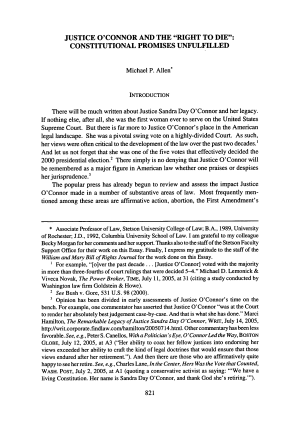Justice O'Connor and the ‘Right to Die’: Constitutional Promises Unfulfilled
February 1, 2006

DISCLAIMER: This text has been transcribed automatically and may contain substantial inaccuracies due to the limitations of automatic transcription technology. This transcript is intended only to make the content of this document more easily discoverable and searchable. If you would like to quote the exact text of this document in any piece of work or research, please view the original using the link above and gather your quote directly from the source. The Sandra Day O'Connor Institute does not warrant, represent, or guarantee in any way that the text below is accurate.
Article Text
(Excerpt, Automatically generated)
JUSTICE O'CONNOR AND THE "RIGHT TO DIE": CONSTITUTIONAL PROMISES UNFULFILLED
Michael P. Allen*
INTRODUCTION
There will be much written about Justice Sandra Day O'Connor and her legacy. If nothing else, after all, she was the first woman ever to serve on the United States Supreme Court. But there is far more to Justice O'Connor's place in the American legal landscape. She was a pivotal swing vote on a highly-divided Court. As such, her views were often critical to the development of the law over the past two decades.1 And let us not forget that she was one of the five votes that effectively decided the 2000 presidential election.2 There simply is no denying that Justice O'Connor will be remembered as a major figure in American law whether one praises or despises her jurisprudence.3
The popular press has already begun to review and assess the impact Justice O'Connor made in a number of substantive areas of law. Most frequently men tioned among these areas are affirmative action, abortion, the First Amendment's
- Associate Professor of Law, Stetson University College of Law; B.A., 1989, University of Rochester; J.D., 1992, Columbia University School of Law. I am grateful to my colleague Becky Morgan for her comments and her support. Thanks also to the staff of the Stetson Faculty Support Office for their work on this Essay. Finally, I express my gratitude to the staff of the William and Mary Bill of Rights Journal for the work done on this Essay.
1 For example, " [o]ver the
